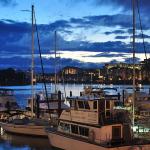
(Wikimedia Commons public domain image)
Surprise! Something has just been posted on the website of the Interpreter Foundation: Interpreter Radio Show — July 9, 2023
In the 9 July 2023 episode of the Interpreter Radio Show, Martin Tanner, John Gee, and Kevin Christensen discussed Come, Follow Me New Testament lesson 32, Jeremy Runnells and John Dehlin‘s claim that “second sight” means “imagination,” and the article this week by John Gee. They were then joined by historian Ron Esplin to discuss his new Brigham Young Papers Project and its first volume, which will be published in August. Their conversation is now available, shorn of commercial breaks and without any charge, at the link given above.
The “New Testament in Context” portion of this show, for the Come, Follow Me New Testament lesson 32, “A Minister and a Witness,” covering Acts 22–28, will also be posted separately on Tuesday, 25 July 2023.
The Interpreter Radio Show can be heard weekly on Sunday evenings from 7 to 9 PM (MDT), on K-TALK, AM 1640, or you can listen live on the Internet at ktalkmedia.com.
Now, though, I want to share a few more passages from Logan Paul Gage, “Understanding Design Arguments,” in Ann Gauger, ed., God’s Grandeur: The Catholic Case for Intelligent Design (Manchester, NH: Sophia Institute Press, 2023), 20-31. Logan Paul Gage earned his doctorate in philosophy at Baylor University and currently chairs the Department of Philosophy at the Franciscan University of Steubenville. Ann Gauger, the overall editor of the volume in which Professor Gage’s article appears, is Director of Science Communication and a Senior Fellow at the Discovery Institute Center for Science and Culture, and Senior Research Scientist at the Biologic Institute in Seattle, Washington. She earned a bachelor’s degree from the Massachusetts Institute of Technology and received her Ph.D. from the Department of Zoology at the University of Washington, in Seattle. Thereafter, she held a postdoctoral fellowship at Harvard University, where her work focused on the molecular motor kinesin. She serves as an editor of the journal BIO-Complexity, and her scientific work has been published in Nature, Development, Journal of Biological Chemistry, Genetic Regulation of Development, In Vitro, In Vitro Cell and Developmental Biology, BIO-Complexity, and Biological Information: New Perspectives.
But let’s not forget about Professor Gage. Here’s one of the passages from him that I marked:
As far back as Socrates in the fifth century BC, we see the father of Western philosophy making an explicit design argument. His student Xenophon records Socrates’s view that we have been most favored by the supreme deity. We are uniquely arranged in body and mind. All other things appear to be here for our benefit. And nature itself seems consistently arranged in the best or finest way. All of this, Socrates argues, bears witness to divine providence.The opposing narrative came from the Greek atomists like Democritus, Leucippus, and Epicurus. Humans, they claimed, are intelligent of course. But this intelligence is a late arrival on the scene. Ultimate reality isn’t intelligent. What fundamentally exists are atoms and empty space in which the atoms collide. Just as you hear many today saying silly things like, “Love is just a chemical reaction in the brain,” so too did the atomists believe that all phenomena really reduce down to the properties of material bodies. For the atomists, highly organized beings like ourselves self-organize by accident. There are an infinite number of worlds. So with an infinite amount of time, every combination of atoms must manifest itself somewhere! Sure, organisms look intelligently designed, but poor accidental designs disappeared while good accidental designs survived. . . .There is truly nothing new under the sun. There are differences, to be sure, but the atomist narrative clearly anticipates not only Darwin’s theory but multiverse scenarios as well. (21)
As even Richard Dawkins recognizes, “Biology is the study of complicated things that give the appearance of having been designed for a purpose.” Like the atomists before him, of course, he thinks this design is only apparent and not real. (22)
And, from what I’ve read, I think that this distinction is spot on though often ignored by critics who can’t be bothered to take a serious look at the matter:
Creationism begins with the biblical text and attempts to reconcile scientific information with a certain understanding of the biblical narrative. Intelligent design begins with the scientific data and argues that it is far more likely the product of intelligence than unplanned accident.

We started this morning off with a stroll through the “ancient cedars” along Ucluelet’s Wild Pacific Trail. They are huge and very complicated in their root structure and branches. They’re estimated to be about eight hundred years old, making them rough contemporaries of England’s King John and his enforced signing of Magna Carta, and one of them is more than twelve meters (in other words, more than forty feet) in circumference at its base.
Then we drove back across Vancouver Island, passing by Kennedy Lake and Sproat Lake and through the Cathedral Grove area of lush old-growth forest where we have always stopped for a walk on previous visits. It’s a very other-worldly place, with the sunlight filtering through its soaring eighty-meter-high canopy. Unfortunately, the hiking trails there have been closed off during this trip. We also passed on through Nanaimo, where we enjoyed exceptionally good pizza at Mambo Gourmet Pizza. (That’s a nod to my most obsessive critics, who are sometimes driven into impotent frenzy by my restaurant recommendations.) We also bought some “Nanaimo bars,” for which the town is famous. The bakery on which my foodie son had set his heart was closed today, alas, but we found another source of Nanaimo bars that came recommended. I confess that they don’t do a lot for me, and I don’t think that that’s merely a result of having chosen the wrong purveyor. My tastes simply don’t incline in that direction.
And now it’s dusk here at the southern end of Vancouver Island. Having spent some time in the swimming pool with my wife and a granddaughter, I’m looking out over the Inner Harbour at the last traces of a beautiful sunset. Life is good.
Posted from Victoria, British Columbia













